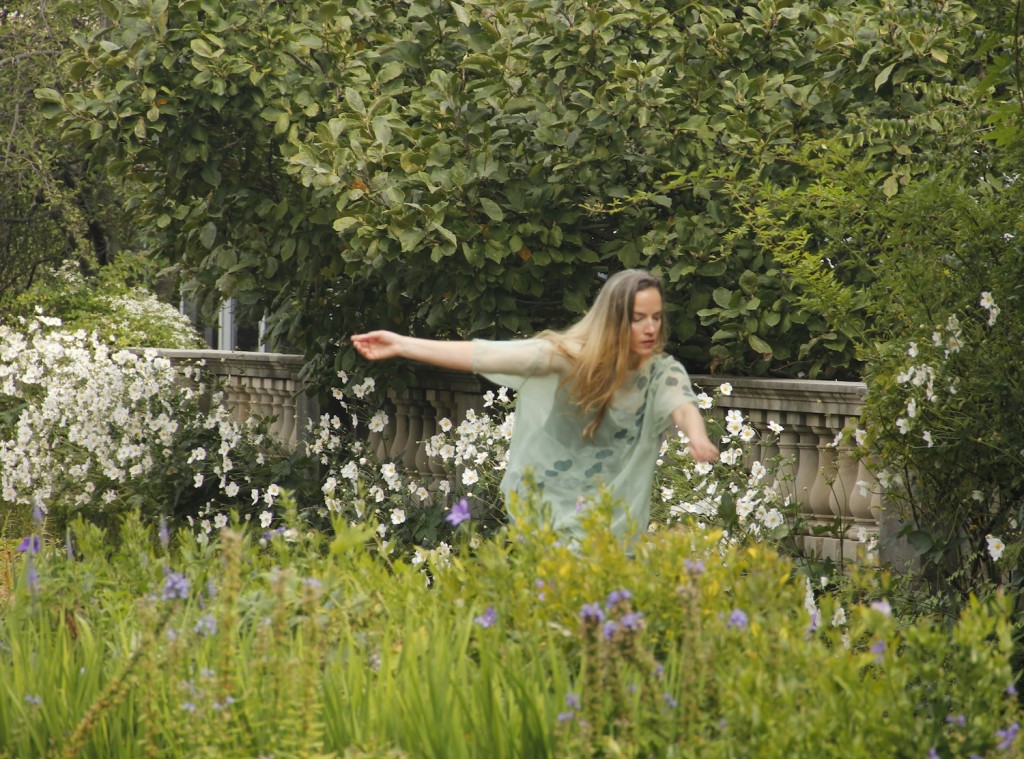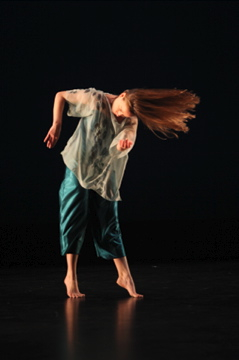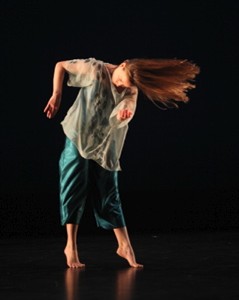“Trisha created a world I never wanted to leave.”

Mariah Maloney was a dancer with the Trisha Brown Dance Company from February 14, 1995, to December 12, 2002, and has since has served on its faculty.
Q: What was your first encounter with Trisha Brown’s work?
Mariah Maloney: On March 9th, 1991 I was an undergraduate student earning a BFA at Purchase College, SUNY. My classmates and I went to see—for the first time—the Trisha Brown Dance Company at City Center in New York City. Today the strong kinesthetic impression I felt in my body while watching the company dance Foray Forêt is still palpable. I remember in Foray Forêt a series of cause and effect moments. Squiggles drawn by a dancer or dancers seemed to vanish as new formations occurred. The dancers careened through the space weaving designs as they cycled and catapulted through center and out to the edges.
The costumes designed by Robert Rauschenberg were made of an effervescent shiny gold fabric. Somehow, the fabric was in contrast to the lush and deeply articulate phrases and choreography and I loved it! I fell in love on the spot with the movement Trisha brought to grace the stage. The dancing and Trisha’s choreography was awe-inspiring. This singular moment at City Center felt amazing and from that moment forward, I was connected to Trisha, her work, and the dancers. Trisha created a world I never wanted to leave.
Q: What you remember about the performance?
MM: I remember in Foray Forêt a quiet moment ignited into a churning choreography that began to dissipate until one delicately articulate female dancer remained on stage. She progressed downstage to perform a simple, sensual and elegant phrase composed of tactile gestures, level changes and body part manipulations. In my tenure with Trisha I explored Foray Forêt phrases; this solo phrase is referred to as “soft phrase.” The night I saw this work Carolyn Lucas performed soft phrase. [See clip below.]
https://vimeo.com/40103514
Somewhere in the middle of the solo a marching band emerged traveling around the perimeter of the theater. The sound of the marching band created a festive atmosphere inside the theater. I began to view the gold clad dancers as spirits gathered in the forest within a Victorian painting. I became curious about the band, was the music distracting the dancers? Was the band meant to be there? Was it ok? Somehow, intuitively I understood that Trisha enjoyed playing with the audience by bringing her work and a marching band together creating a juxtaposition in contexts for the viewer.
Toward the end of the dance Trisha appeared adorned in an elegant flowing dress of muted gold. Alone on the stage, she commanded the eye as she filled the stage with her refined yet feisty dancing. The fabric of her dress billowed into the air as she fired initiation after initiation launching into a jump pushing the ground away from her and swinging her arms taking her body into flight. Eventually Trisha became still and seemed circumspect for a moment before proceeding with a quiet tactile gestural phrase interspersed with valiant rifts. While still engrossed in this solo, my eye was directed to the little splashes of movement that kept peeking out from the stage right and left wings. Trisha’s solo was framed by dancers enacting a question and answer. The last image seen on the stage as the lights faded and the dance came to a close was Trisha’s silky articulations. I sat in my chair wanting to see the dance again wishing it could continue forever. I felt transformed and didn’t want to leave this experience. As the dancers moved through a procession of bows, deep inside my body, I kept experiencing the dancing that had just occurred. I fell in love at first sight with Foray Forêt and Trisha Brown’s work.
Q: What were rehearsals like?
MM: Dancers arrived each day fully present ready to take risk, be accountable, remember, develop, play, and work with Trisha and each other. Rehearsals and performances felt like a rich playground of Trisha’s imagination. The company worked together in creative problem solving. Trisha’s rehearsal process was always at the highest level of focus, body intelligence, resourcefulness and intelligence. Working with Trisha Brown was Awe-inspiring, Exhilarating, Alive, Juicy, Free, Sensual, Organic, Beautiful, Lush, Clear, Nature to Nature, Articulate, Edges, Searching, Becoming, Being, Present, Embodiment of Design, Craft, Fresh, and Felt Good.
If I go back to my early days of rehearsals as a new dancer, I was truly inspired by the rich, beautiful and at times very challenging—transforming into a thoroughly pared-down articulate and intuitive dancer is a big journey—experience of learning from and dancing with the company. I studied the dancers and worked to embody their sense of articulation and sensitivity. I was inspired as well by the dancers commitment to their practices and studies with June Ekman (Alexander Technique) and Susan Klein (Klein Technique).
In terms of the professionalism of the company and Trisha’s vision, Trisha, her board members, and the company organization created a sophisticated, grounded and secure rehearsal and performance schedule and trajectory. As a dancer in the company I appreciated the rehearsal and tour schedule was booked a year ahead of time. I appreciated the three-year contract upon my hire and I appreciated that dancers could expect to spend a year teaching off their roles. I appreciated that I was contracted for a minimum of 38 weeks including medical, dental, and retirement as well as unemployment benefits. I appreciated that on tour hotel accommodations were fine and dancers received a generous per diem. Trisha Brown, her board members, and the company organization ensured Trisha’s work be supported on the highest level. I appreciated it then and I am honored to have had this experience working with the company. I appreciate all Trisha and her board did to support a world-class artist and company.
Q: What was the most challenging aspect of Trisha’s work to master?
MM: The most challenging aspect for me to master was accessing a quiet and clear body. I was naturally inclined toward Trisha’s feisty signature: the one that manipulated gravity, employed wild abandon, and was ready to take risk. It was the quieter phrase work that demanded neutral lines and pared-down articulations that brought me to engage in a meaningful practice of Alexander Technique with mentor June Ekman. I found the less I applied my desire to dance the material the more I was able to fully pare-down my embodiment of the material. The lines became clear and exact. My apprenticeship with Trisha Brown began many years ago and today I continue to search and refine my artistic presence both in the body and in the creation of new solo and group work. I deeply value the breadth for expression I developed through my tenure with Trisha.
Q: If you had one Trisha Brown dance to take with you to a desert isle what would it be and why?
MM: I want to take everything I have ever danced or viewed by Trisha to the desert isle. Why? Because to dance Trisha’s work, to view Trisha’s work is to evolve as a human being. I like to imagine this playing out on a desert isle. If I truly have to pick I will share a short list: Group Primary Accumulation, Set and Reset, Rage/Exhaustion, Ladder, L’Orfeo.
Q: How did your relationship to Trisha’s work evolve during your time with the company?
MM: I was one of a few dancers to have the opportunity to dance Trisha’s role in her signature work Set and Reset. On several occasions during my early years in the company, when Trisha was still dancing her role, I had the opportunity to witness her from backstage. I would quietly witness Trisha’s playful spirit acting on instinct, fully available, delivering fierce clarity and a flowing effervescence. These moments of witnessing Trisha dance taught me everything. I understood from watching her that the movement had a logical path and sense of weight. The body and mind had to be available to allow the natural journey to travel through the body’s torso and limbs. Sometimes falling to cast out and then layer a gesture over a traveling foot phrase—and at the same time keeping track of the other dancers and choreographic game on deck.
I joined Trisha Brown during her music cycle, 1994–2002. At this time she was tackling Bach, Webern, Monteverdi, Sciarrino, and Schubert. To experience the music performed live often on period instruments was a life changing experience. I recall Thomas, an Icelandic bass opera singer, belting out an aria twelve inches away from me—the reverberation coming directly from his vocal chords to my entire body was like nothing I had ev er experienced. Building and performing L’Orfeo in Brussels, New York, London, Aix-en-Provence changed me and deeply educated me. Thank you Trisha.
er experienced. Building and performing L’Orfeo in Brussels, New York, London, Aix-en-Provence changed me and deeply educated me. Thank you Trisha.
It is a gift, the rich process of working intimately as a dancer with Trisha Brown for nearly a decade. This experience instilled a sense of a highly tuned body logic, curiosity, refinement, sensitivity, and most of all an evolution of dancing and being. Inspired and fulfilled by this journey, I continue to follow my instincts in dance and life; I explore and take in information and continue my apprenticeship of growth and evolution as a person who loves dance. There is always more to understand, to embody and to be. I cherish this about my experience dancing Trisha’s work: it inspires me to continue my quest to inquire and savor the possibilities for this art form and what it can become.
Q: What stays with you the most about Trisha’s work today?
MM: I have carried with me the inquiry of the body as source and the imagination as source. I cherish the feeling of dancing in a well organized body and having access to articulate design and ease in body action. To see—what do we see? Dancing with Trisha taught me to see in a refined way. Through the rigorous rehearsal process of building material and rehearsing repertory I learned to discern details, pathways, weight and design through a subtle and highly refined lens. Today I find myself noticing life around me as a landscape for invention and reflection in my own choreography and improvisation. I find myself doing this each day. Noticing the logical and idiosyncratic patterns in nature. The layering n nature invites my eye to notice the systems of decay and rebirth that are in an ongoing ever replenishing cycle. Dancing with Trisha brought me to a feeling of freedom similar to the one I experienced as a child running through the forest of the Kachemak Bay. One leader would fall away to the back as another would begin to lead, navigating the rolling forest path designed with root systems and cushioned by soft spruce needles padding each falling footstep. My twin sister and I would lose track of time and be out and about in the Alaskan landscape well past bedtime. Dancing with Trisha brought me to a rich world. Sometimes I felt like I was as free as a child playing in nature and other times I felt the freedom of embodiment where we danced as highly skilled artists supremely navigating Trisha’s choreography with ease and refinement.
Some of my favorite moments with Trisha include the few times when she appeared backstage softly said, “Be your most gracious self.” Dancing with Trisha Brown brought me to know my most gracious self. Thank you Trisha.
Top photo: Mariah Maloney performing her choreography Irish Solo: Turas (2008).

